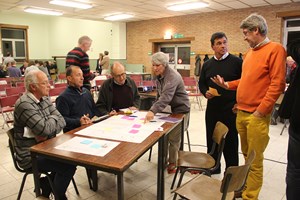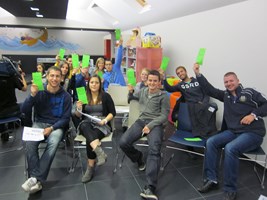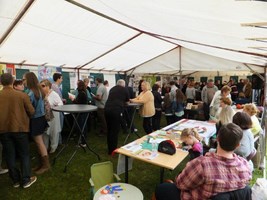[EXP] Local rural development committees in Wallonia (Belgium): a local space for consultation and forming proposals, integrating inhabitants and elected officials.
Rural topic(s): Civic dialogue, Civic engagement, local governance and dialogue
Type: Success story
Date of writing: February 16, 2015
Author(s) of this page: Pierre-Yves Guiheneuf
Organization(s): FRW (Rural Foundation of Wallonia)
Summary:

Local rural development committees (CLDR) are committees of inhabitants and locally elected officials who have come together to define action plans on the communal level, on the initiative of the Walloon Region.
Text:
Context
The Walloon Region has encouraged the creation of local rural development committees (CLDR) since the start of the 2000s. Currently (2015), around a hundred communes have a committee.
Partners
The CLDR (Commission Local de Développement Rural) is a group consisting of 25% locally elected officials and 75% citizens representing different parts of the commune, age groups, sexes and socio-professional categories.
Activities
The CDLR consists of elected officials and citizens. Citizens are selected after a call for candidates, and a diverse range of profiles is sought. These committees fall within the framework of a Decree by the Walloon Region and their composition must be approved by the Minister.

The CLDR is a place for discussing and drafting proposals which are submitted to the Communal Council, which takes the decisions. It meets a minimum of four times a year in plenary session. It organises and coordinates working groups (open to all inhabitants wishing to take part) to look into a subject in more depth, to suggest a project, to carry out a specific action, etc. It also organises public meetings in the villages to clarify projects which are about to start, to react to development plans, etc…

Communes can organise CLDRs through the local authority. A commune may also ask the Minister for Rural Affairs for support from the Fondation Rurale de Wallonie, which then organises the committee and the initial training of its members. Finally, it may call upon consultants who will be responsible for organisation. In any case, it launches a public call to elect a research group to draft the communal rural development programme, in close relationship with the CLDR.
The rural committee is consulted on the various analyses carried out by external service providers on the commune, which allows inhabitants’ views to be compared to those of the experts.
Results and prospects

Currently, around one hundred communes have an operating CLDR. By means of example, that of the commune of Sombreffe (9,000 inhabitants) suggested a ten year development strategy to the communal council, called the Programme Communal de Développement Rural (PCDR). This programme was drafted around three priority areas:
-
a social priority aiming to meet the essential needs of the population;
-
a priority relating to rural development and the natural environment;
-
a priority relating to village cohesion and socio-cultural life.
The commune then established a whole series of projects as the result of the Programme Communal de Développement Rural: development of a public square; creating a greenway between Sombreffe and Ligny; the ecological management of the surrounding area. Other projects are underway: developing a multi-service centre; construction of affordable rented housing; construction of a village hall.
The commune manages the projects, and at least 20% of funding must be provided by the commune. They may also benefit from other public aid.

For Jocelyne Van Lierde from the Fondation Rurale de Wallonie which manages the CLDR in Sombreffe, there are many advantages of having inhabitants participate: combining their views with those of experts to achieve a shared vision, better integration of projects and better ownership among inhabitants.
Comments:
The originality of this experiment is that it has chosen:
1) a local committee consisting of local volunteers who are not necessarily involved in organisations or professional bodies;
2) to complete this committee, which is a permanent focus for citizen participation and which represents of the communal council, with regular meetings which are open to all citizens (committee working groups, public meetings);
3) to call upon organisers, either a local official or an external person (employee of the Fondation Rural de Wallonie or a consultant).
Notes:
www.sombreffe.be/commune/participation-citoyenne/developpement-rural-la-cldr
Contact:
Jocelyne Van Lierde (animatrice, agent de développement de la Fondation Rurale de Wallonie).Rue de Clairvaux, 40 bte 01 1348 Louvain-la-Neuve tél : 010/237804. E-mail : j.vanlierde (a) frw.be
Download:
Informations:
Scale of intervention : Local
Keywords: citizen participation, consultation process, public authorithy initiative, local community initiative, concertation, integrated rural development
Places: Belgium
Actors: municipality, inhabitants, citizen
Methods: field trip, training/capacity-building, working group
